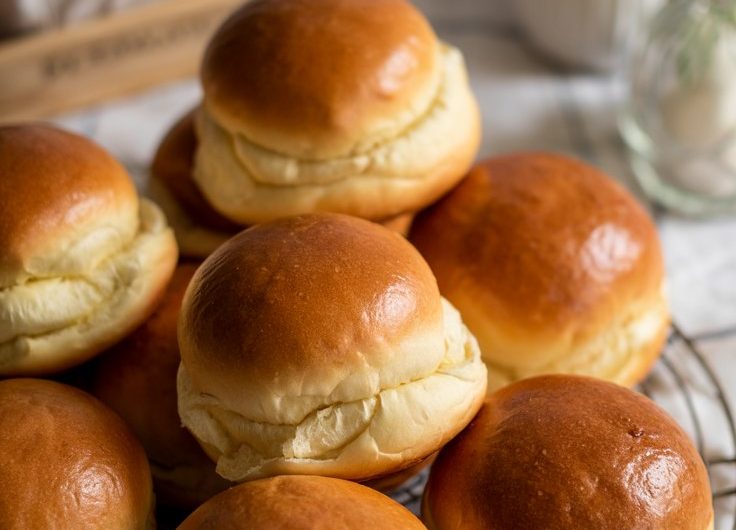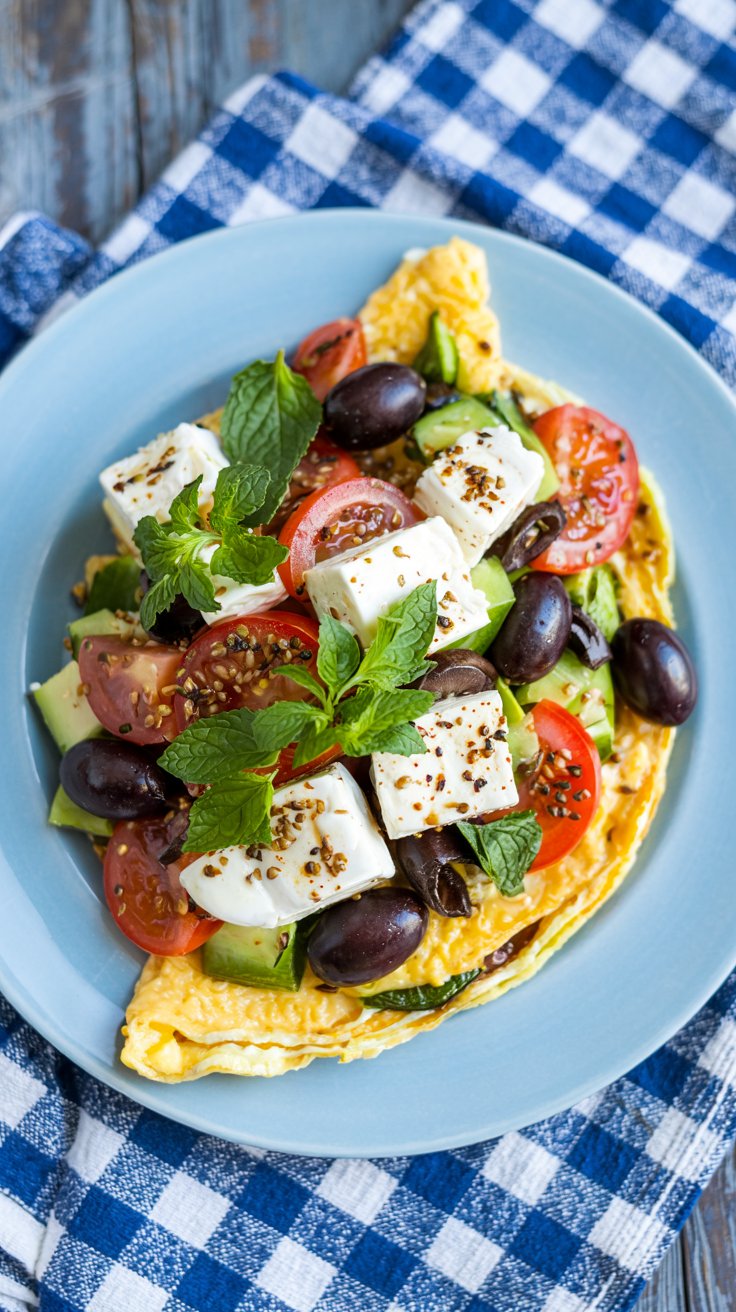Brioche Buns
Brioche Buns are soft, golden, and gently sweet. They sit somewhere between bread and pastry, with a tender crumb that makes them perfect for burgers, breakfast sandwiches, or just torn warm from the pan and eaten with butter. These buns aren’t flashy. They’re simple and reliable, the kind of recipe you can make on a lazy Saturday and feel quietly proud of when they come out of the oven, glossy and warm.
If you’ve never made enriched dough before, don’t worry. It’s a little sticky at first, but it tells you what it needs. A few minutes of kneading, a little patience, and the dough softens under your hands. The kitchen smells like butter and summer evenings. You’ll know they’re right when you tap the bottom of a cooled bun and hear that light, hollow sound.
Ingredients for this Brioche Buns
- 3 to 3 1/4 cups (360–390 g) bread flour, plus extra for dusting
- 2 teaspoons instant yeast (or 2 1/2 teaspoons active dry yeast)
- 3 tablespoons (38 g) granulated sugar
- 1 1/4 teaspoons fine sea salt
- 1/2 cup (120 ml) warm milk, about 100–110°F (38–43°C)
- 1/4 cup (60 ml) warm water
- 2 large eggs, at room temperature
- 1/2 cup (115 g) unsalted butter, very soft but not melted
- 1 tablespoon honey (optional, for extra tenderness)
- 1 egg beaten with 1 tablespoon milk, for egg wash
- Sesame seeds or poppy seeds (optional)
Instructions
- Bloom the yeast (if using active dry): In a small bowl, combine the warm milk, warm water, and sugar. Sprinkle in the active dry yeast, stir, and let it sit for 5–10 minutes until foamy. If using instant yeast, skip this step and add it directly to the flour.
- Make the dough: In a large bowl (or the bowl of a stand mixer), stir together 3 cups (360 g) of flour, salt, and instant yeast (if using). Add the milk-water mixture, eggs, and honey (if using). Mix until a shaggy dough forms. It will look messy… that’s fine.
- Knead and add butter: Knead by hand on a lightly floured surface or with a dough hook on medium-low. After 2–3 minutes, start adding the soft butter, a tablespoon at a time, letting each piece disappear before adding the next. Keep kneading for 8–10 minutes more, until the dough is smooth, elastic, and slightly tacky but not sticky. If it’s soupy, sprinkle in up to 1/4 cup more flour, one tablespoon at a time. You’re aiming for a soft pillow, not a dry ball.
- First rise: Shape the dough into a ball and place it in a lightly greased bowl. Cover with a clean towel or plastic wrap. Let rise in a warm spot until doubled, 1 1/2 to 2 hours. Tip: a turned-off oven with the light on is perfect. If your kitchen is cool, it may take closer to 2 1/2 hours. Be patient.
- Chill briefly (optional but helpful): Pop the bowl into the fridge for 20–30 minutes. Slightly chilled dough is easier to handle and shape, especially when enriched with butter.
- Divide and pre-shape: Gently deflate the dough onto a lightly floured counter. Divide into 8 equal pieces (about 90–95 g each). Tuck edges under to make rough balls. Let them rest for 10 minutes, uncovered. This short rest relaxes the gluten and makes shaping smooth.
- Final shape: Working one at a time, cup your hand around a dough piece and drag it lightly on the counter in small circles to create surface tension. You’ll feel it tighten into a neat, smooth ball. Arrange on a parchment-lined baking sheet with space between each (they spread).
- Second rise: Cover loosely with lightly greased plastic wrap. Let rise until puffy and about 50% larger, 60–90 minutes. They should jiggle if you nudge the pan. If you poke gently, the dent should spring back slowly, not immediately.
- Preheat and glaze: Heat the oven to 375°F (190°C). Brush the buns with egg wash. Sprinkle with sesame or poppy seeds if you like.
- Bake: Bake for 15–18 minutes, rotating the pan once, until deep golden all over. If you have a thermometer, the center should be around 200°F (93°C). If they’re browning too fast, tent loosely with foil for the last few minutes.
- Cool: Let the buns cool on the pan for 5 minutes, then transfer to a rack. They’ll finish setting as they cool. Yes, it’s hard to wait. Give them at least 15–20 minutes before slicing so the crumb stays fluffy.
Serving idea: split, toast lightly, and spread with butter and jam. Or make a smash burger with a ripe tomato and crisp lettuce… you’ll taste why homemade is worth it.
Cook and Prep Times
- Active prep: 25–30 minutes
- First rise: 1 1/2–2 hours (longer if your kitchen is cool)
- Optional chill: 20–30 minutes
- Second rise: 60–90 minutes
- Bake: 15–18 minutes
- Total: about 4–5 hours, mostly hands-off
- Overnight option: After the first rise, punch down, cover tightly, and refrigerate up to 12 hours. Shape cold dough in the morning, proof 1 1/2–2 hours, then bake.
Nutritional information
Approximate per bun (8 buns): 315 calories; 12 g fat; 41 g carbohydrates; 7 g protein; 2 g fiber; 7 g sugar; 350 mg sodium. These numbers will vary slightly based on flour brand, butter, and toppings.
Frequently asked questions
Can I make Brioche Buns without a stand mixer?
Yes. The dough is enriched and a bit sticky, but it’s doable by hand. Use a bench scraper to keep things tidy. Knead with a “slap and fold” motion: pick up the dough, slap it on the counter, fold it over itself, and repeat. It will go from shaggy to silky in about 10–12 minutes. A short rest (5 minutes) halfway through helps the dough relax and makes kneading easier.
Can I freeze the buns (or the dough)?
To freeze baked buns, cool completely, wrap individually, and freeze up to 2 months. Thaw at room temperature and refresh in a 300°F (150°C) oven for 5–7 minutes. To freeze the dough, shape into buns after the first rise, freeze on a tray until firm, then bag. When ready to bake, thaw overnight in the fridge, proof at room temp until puffy, and bake as directed.
Why did my buns turn out dense?
Most often, they needed more time to rise or the dough was too dry. Aim for a soft, slightly tacky dough; add flour only as needed while kneading. Check your yeast freshness and water/milk temperature (too hot can kill yeast; too cold slows it way down). During the second rise, let the shaped buns get good and puffy—the poke test is your friend. A gentle, slow spring back means they’re ready for the oven.
A small tip from my own kitchen: if you’re baking on a cool day, sit the covered tray on a warm (but not hot) stovetop while the oven preheats. That little nudge of warmth makes the second rise steady and predictable. And when you lift those Brioche Buns out—shiny, golden, smelling like a bakery—you’ll be glad you gave the dough the time it asked for.
One last thing. Save the end pieces. Tomorrow morning, make a simple breakfast sandwich: egg, cheese, a slice of tomato, a grind of pepper. The bun will toast up with a thin, crisp edge, and the middle will stay cloud-soft. Nothing fancy. Just perfect bread doing what it does best.
Brioche Buns
8
servings30
minutes18
minutes315
kcalBrioche Buns are soft, golden, and gently sweet. They sit somewhere between bread and pastry, with a tender crumb that makes them perfect for burgers, breakfast sandwiches, or just torn warm from the pan and eaten with butter. These buns aren’t flashy. They’re simple and reliable, the kind of recipe you can make on a lazy Saturday and feel quietly proud of when they come out of the oven, glossy and warm.
Ingredients
3 to 3 1/4 cups (360–390 g) bread flour, plus extra for dusting
2 teaspoons instant yeast (or 2 1/2 teaspoons active dry yeast)
3 tablespoons (38 g) granulated sugar
1 1/4 teaspoons fine sea salt
1/2 cup (120 ml) warm milk, about 100–110°F (38–43°C)
1/4 cup (60 ml) warm water
2 large eggs, at room temperature
1/2 cup (115 g) unsalted butter, very soft but not melted
1 tablespoon honey (optional, for extra tenderness)
1 egg beaten with 1 tablespoon milk, for egg wash
Sesame seeds or poppy seeds (optional)
Instructions
- Bloom the yeast (if using active dry): In a small bowl, combine the warm milk, warm water, and sugar. Sprinkle in the active dry yeast, stir, and let it sit for 5–10 minutes until foamy. If using instant yeast, skip this step and add it directly to the flour.
- Make the dough: In a large bowl (or the bowl of a stand mixer), stir together 3 cups (360 g) of flour, salt, and instant yeast (if using). Add the milk-water mixture, eggs, and honey (if using). Mix until a shaggy dough forms. It will look messy… that’s fine.
- Knead and add butter: Knead by hand on a lightly floured surface or with a dough hook on medium-low. After 2–3 minutes, start adding the soft butter, a tablespoon at a time, letting each piece disappear before adding the next. Keep kneading for 8–10 minutes more, until the dough is smooth, elastic, and slightly tacky but not sticky. If it’s soupy, sprinkle in up to 1/4 cup more flour, one tablespoon at a time. You’re aiming for a soft pillow, not a dry ball.
- First rise: Shape the dough into a ball and place it in a lightly greased bowl. Cover with a clean towel or plastic wrap. Let rise in a warm spot until doubled, 1 1/2 to 2 hours. Tip: a turned-off oven with the light on is perfect. If your kitchen is cool, it may take closer to 2 1/2 hours. Be patient.
- Chill briefly (optional but helpful): Pop the bowl into the fridge for 20–30 minutes. Slightly chilled dough is easier to handle and shape, especially when enriched with butter.
- Divide and pre-shape: Gently deflate the dough onto a lightly floured counter. Divide into 8 equal pieces (about 90–95 g each). Tuck edges under to make rough balls. Let them rest for 10 minutes, uncovered. This short rest relaxes the gluten and makes shaping smooth.
- Final shape: Working one at a time, cup your hand around a dough piece and drag it lightly on the counter in small circles to create surface tension. You’ll feel it tighten into a neat, smooth ball. Arrange on a parchment-lined baking sheet with space between each (they spread).
- Second rise: Cover loosely with lightly greased plastic wrap. Let rise until puffy and about 50% larger, 60–90 minutes. They should jiggle if you nudge the pan. If you poke gently, the dent should spring back slowly, not immediately.
- Preheat and glaze: Heat the oven to 375°F (190°C). Brush the buns with egg wash. Sprinkle with sesame or poppy seeds if you like.
- Bake: Bake for 15–18 minutes, rotating the pan once, until deep golden all over. If you have a thermometer, the center should be around 200°F (93°C). If they’re browning too fast, tent loosely with foil for the last few minutes.
- Cool: Let the buns cool on the pan for 5 minutes, then transfer to a rack. They’ll finish setting as they cool. Yes, it’s hard to wait. Give them at least 15–20 minutes before slicing so the crumb stays fluffy.








